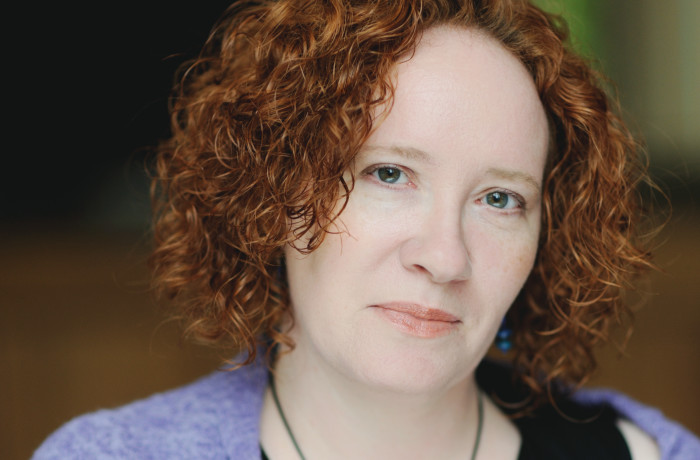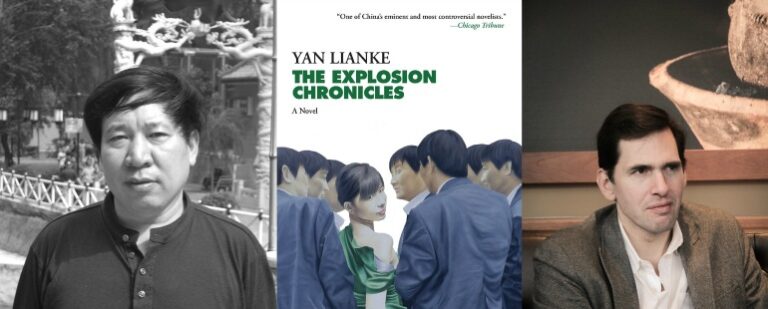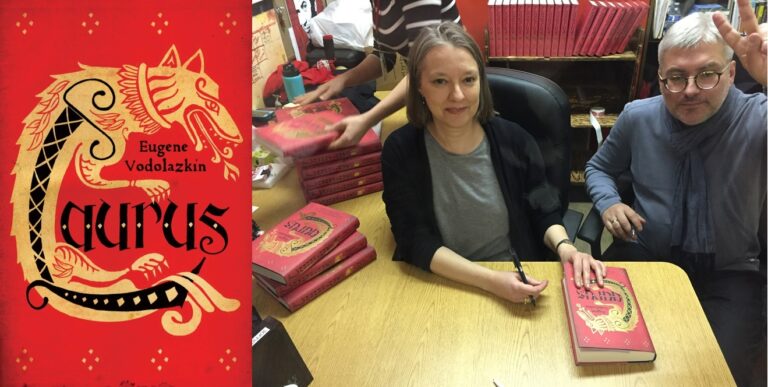“If an object entered my life somehow, I would put it in the book and see what happened”: An Interview with Ruth Ozeki

Ruth Ozeki’s latest novel, The Book of Form and Emptiness (2021), tells the story of the young teenager Benny Oh and his mother, Annabelle. Their lives slowly unravel after the death of Benny’s father, Kenji, a jazz clarinetist who is hit one night by a truck carrying crates of chickens. Living in the wake of this traumatic loss, Benny begins hearing voices. Objects like windows, scissors, and even books begin talking to him. Annabelle’s grief comes out in a similar way: she is unable to let go of the piles of everyday stuff—crafts, clothes, papers, CDs—that have taken over her home, and her hoarding pushes Benny away.
Objects are characters in The Book of Form and Emptiness. And as Ozeki’s masterful structure makes clear, we, the readers, are hearing voices too. The Book—that is, the object that I hold in my hands as I read and turn its pages—is talking to me, narrating Benny’s story. Benny talks back to the Book intermittently, offering his own version of events when he feels it is necessary. But the Book has a mind of its own.
When I read The Book of Form and Emptiness, it seemed fitting to me that Ozeki chose the German-Jewish intellectual Walter Benjamin as Benny’s spiritual guide. Few writers were more fascinated with the magical powers and potential autonomy of objects than Walter Benjamin. His interests were astonishingly broad. He wrote about children’s toys, Mickey Mouse, politics, photography, nineteenth-century Paris, German tragic drama, and of course, books. He wrote extensively on the power of objects under the conditions of capitalism. Tapping into deep psychological desire, objects can hypnotize us, convincing us to collect and keep more and more of them until they take over our lives. But Benjamin knew that they could also enchant us, suggesting alternative ways of valuing trash, nature, and history.
Benjamin’s words serve as epigraphs to The Book of Form and Emptiness’s five parts. But Benjamin also shapes Benny’s fate. His words lead Benny to a girl who calls herself the Aleph—a troubled runaway who steals his heart—and the Bottleman, an old hobo poet who hangs out in the washroom of the public library. Benny discovers a postcard tucked into a book after he begins to cut school and spend his days at library. The postcard shows Paul Klee’s Angelus Novus, a small, child-like watercolor from 1920 that Benjamin imagined as the Angel of History. In his “Thesis on the Philosophy of History,” Benjamin wrote:
His face is turned toward the past. Where we perceive a chain of events, he sees one single catastrophe which keeps piling wreckage upon wreckage and hurls it in front of his feet. The angel would like to stay, awaken the dead, and make whole what has been smashed. But a storm is blowing from Paradise; it has got caught in his wings with such violence that the angel can no longer close them. The storm irresistibly propels him into the future to which his back is turned, while the pile of debris around him grows skyward. The storm is what we call progress.
When Benny discovers the postcard, he doesn’t know what to think of Walter Benjamin—or Valter Benyameen, as the Aleph instructs Benny to pronounce it. He has concerns about their similar names and worries “that any Benjamin could be depressed enough to kill himself.” But ultimately, Benjamin guides Benny to accept the independent lives of objects and acknowledge the trauma of his own historic moment.
I think a lot about Benjamin. Most historians of photography like me do. But his life and death seem to have something important to teach all of us during our current moment of fascism, forced migration, and cultural censorship. Benjamin was born in Berlin in 1892. When the Nazis seized power in 1933, Benjamin escaped to Paris, a city that enchanted him throughout his life. Benjamin remained in Paris, working away at his writing despite the desperate urging of his closest friends to leave. He was interned by the Nazis for two months shortly after war broke out in 1939. Still, Benjamin refused to leave until the following year. He eventually joined more than two million other refugees that crossed the Pyrenees to reach Portugal. Along the grueling journey, Benjamin clutched a leather briefcase, claiming its contents were “more important than myself.” The journey was not successful. Facing deportation back to France, Benjamin died by suicide. The briefcase was never found.
I recently spoke with Ozeki about her interest in Benjamin and his presence in The Book of Form and Emptiness over Zoom. As Ozeki and I began discussing The Book of Form and Emptiness, she held up a snow globe filled with a friendly green turtle and swirling glitter. Then she showed me a slip from a fortune cookie: “The world is a beautiful book for those who read it.” These objects inspired Ozeki to explore our deep and irrational connections to objects. In the novel, Annabelle covets snow globes and displays them next to her at-home workstation, Mission Control, where she monitors the news. Satirical snow globes of environmental disaster are made by Benny’s beloved the Aleph. The particles that whirl around inside recall debris that collects at the feet of Benjamin’s Angel of History. Heady messages written on pieces of paper involve Benny in a Fluxus-style scavenger hunt of references and connections through the public library.
Ozeki informed me that Benjamin collected snow globes. His close friend Theodor Adorno recalled that they were counted among his favorite belongings. Snow globes contain a world under glass. They are kitschy objects of little use, but for Benjamin and Ozeki, they capture something about the magic of objects themselves. They contain possibilities of alternative existence and suggest a life for objects beyond their utilitarian purpose.
Pepper Stetler: Can you talk about how you decided to weave Walter Benjamin into The Book of Form and Emptiness?
Ruth Ozeki: When I started writing the book I had no idea at all of putting in Walter Benjamin. But all of my novels have historical figures who act kind of like guiding spirits. Their words serve as epigraphs and punctuate each chapter; characters reference the historical figures as well. I hadn’t come up with a ghost for this book yet. But I was writing about objects that had vitality and spirit, and a lot of the book was set in a library. I made this rule for myself: if somebody gave me something, or if an object entered my life somehow, I would put it in the book and see what happened. And so a friend of mine came back from vacation and gave me a snow globe, so that made it into the book. Then there were slips from fortune cookies I encountered and many other things like this. Around the same time, I was researching the performance artist Laurie Anderson, who referenced Benjamin in her song “The Dream Before.” Then my agent, Molly Friedrich, suggested I look at “Unpacking my Library,” given that much of the novel was set in a library. And that sealed it. I started to read more Benjamin and everything started to line up in the most beautiful way. Benjamin was a collector. You could say that he was a hoarder, even. I just started reading everything in a dilettantish sort of way. I’m kind of a flâneur of Benjamin’s work.
PS: Well, I never trust people who call themselves Benjamin experts. His writing is so chaotic! He wrote on Mickey Mouse and an academic study on the origins of German tragic drama. I don’t think anyone can ever feel like they fully understand all of Benjamin’s writing.
RO: Reading Benjamin is like walking down an arcade and seeing all of the disparate material. Some of it is very serious and some of it is very fun. So I very much felt like a flâneur. But for me, Benjamin’s interests ended up giving the novel a thematic shape. He nudged me toward a more pronounced focus on materialism.
And then Trump was elected and I was reading about Benjamin’s last days. I was really feeling the encroachment of fascism and the parallels between these two moments. There was a time when I wasn’t sure when this story was going to be set, but after Trump’s election it became very clear to me that it had to be 2016. I realized that the Bottleman would be the perfect character to tell the story of Benjamin’s death in the novel. And that’s how the Bottleman got his briefcase. The idea of the Bottleman carrying his briefcase up the mountain and then losing his briefcase was inspired by Benjamin carrying his briefcase with him over the Pyrenees. He said that it was more important than his life, but then it was lost. And because this story is being told by a book, this would be the greatest tragedy of all. That a book would be lost!
It was also Walter Benjamin’s influence that made me start thinking about capitalism and bringing capitalism into the book in an overt way. Benjamin’s ideas relate to capitalism, but they are also very Buddhist. That idea that our desires are insatiable is fundamental to Buddhism. It was a way in which a capitalist critique and a Buddhist critique could kind of constellate and live in the same moment.
PS: Benjamin had a remarkable perspective on capitalism and its position in a broader history of human experience. Can you say more about what interested you about Benjamin’s conception of history?
RO: The way we visualize time is of course very progress oriented. We think about the future being ahead of us and the past behind us. But there are many cultures that don’t see it that way. Benjamin’s idea is that the future is behind us and we can’t see it, but we can see the past. It coincides with what Benjamin was describing in Paul Klee’s Angelus Novus. If you view time like Benjamin, then you are also changing the past because of what you are aware of in the present. That is at the core of Benjamin’s way of reinterpreting history. This was swirling around in my head, and I was listening to Laurie Anderson’s lyrics about Hansel and Gretel. And from this came the scene in the library with Benny, where Benjamin actually enters the text of the novel. Benny and the Aleph start talking about that image by Paul Klee.
PS: Benny’s mother, Annabelle, never knows about Benjamin’s life or his ideas at all, but her character really embodies the piling up of catastrophes and the inability of a person to sufficiently deal with their past. She shows us the way in which materialism and collecting can turn into hoarding. Can you say a little about how her character changed when you found Benjamin as a spiritual guide?
RO: There was a time when I was thinking of calling Annabelle “Angela” because I was thinking of her as a kind of angel of history. Inadvertently, that is really her role. As a media collector, all of the catastrophes pile up, quite literally, on her doorstep. And she has a very Walter Benjamin-like innocence in her attachment and attraction to things. She sees the potential in everything. Everything is fraught with meaning. Her collection of the snow globes, her connoisseurship—she is a hoarder, but she is also a connoisseur. Those two impulses can co-exists in fascinating ways.
PS: I’ve been thinking a lot lately about how to read our own moment in history. In other words, how can we use history to make the best choices about our actions in the present. How can we use the past to make decisions about the future? Do you think this is why Benjamin’s still resonates with us today, almost eight decades after he wrote?
I think we are all thinking about that. My husband is Canadian but his parents were German refugees. His father was in the Hitler youth army. His mother was in Stuttgart during the bombings. His life, as was mine, was very much shaped by the forces of fascism and World War II. It is an important time to be reading Walter Benjamin, who was forced out of places. There’s some account of him holing up in the Bibliotheque Nationale in Paris and basically just refusing to move. He found refuge in the library and resisted the reality of his circumstances—that he was going to have to leave on his own two feet. As I was writing the book, I was reading this and thinking about what it takes to leave. How can we know that it is time to leave?


